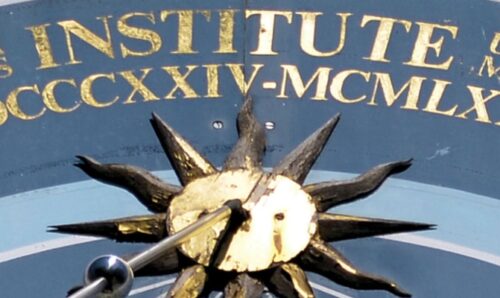Squid – a 200 million-year-old delicacy
Departments Research impact and institutes 3 October 2017
Ever wondered what was on the menu 200 million years ago? Well, if you like calamari, you’ll be pleasantly surprised to discover that not much has changed.
New research by one of the leading experts in ichthyosaurs Dean Lomax has discovered the potential source of the newborn reptile’s diet: squid. What’s interesting is this isn’t the normal diet of older ichthyosaurs, but seems to have been favoured by newborns exclusively.
Last supper
 The discovery was made by Lomax as he examined what is currently the smallest and youngest specimen of ichthyosaur communis (to give it its full name) ever discovered. He was able to identify it as a newborn of the species thanks to the arrangement of the bones in its skull.
The discovery was made by Lomax as he examined what is currently the smallest and youngest specimen of ichthyosaur communis (to give it its full name) ever discovered. He was able to identify it as a newborn of the species thanks to the arrangement of the bones in its skull.
So, why does it matter that this little critter chowed down on squid? Lomax explains: “[It’s] interesting because a study by other researchers on a different type of ichthyosaur, called Stenopterygius, which is from a geologically younger age, found that the small – and therefore young – examples of that species fed exclusively on fish. This shows a difference in prey-preference in newborn ichthyosaurs.”
And if you’re wondering how he can be so sure that it was definitely a squid the youngster enjoyed as a last supper, the little hooks found on the arms of prehistoric squid were perfectly preserved between the ribs of the baby ichthyosaur.
When’s a dinosaur not a dinosaur?

Ichthyosaurs are known for their dolphin-like shape. One particular type, the Ophthalmosaurus, has the largest eyes for its size of any creature ever discovered.
We’ve busted a few Jurassic Park myths on The Hub before, and today we’re at it again. The baby ichthyosaur Lomax discovered dates back to the Jurassic age, and so could have been featured splashing around the pool alongside the colossal mosasaur at the end of Jurassic World. However, what these two dinosaurs have in common is that neither of them are actually dinosaurs.
While there’s yet to be a clear-cut agreement of the ichthyosaur’s evolutionary origins, it’s generally agreed that it developed from the Amniotes group – animals that lay eggs on land. Ichthyosaurs are classed as marine reptiles rather than dinosaurs – although they’re also very different to reptiles, which makes working out their ancestral history tricky.
An eggcellent myth-buster

So, ichthyosaurs aren’t dinosaurs, they’re marine reptiles – which means they must lay eggs like other marine reptiles, right? Well, no – wrong again!
While other marine reptiles like turtles and crocodiles do head on to land to lay their eggs, the streamlined shape of the ichthyosaur that made it so suited to swimming also made it close-to impossible to get on to land. As a result, the mothers would give birth to their young live and in the water.
Lomax was recently invited to examine an ichthyosaur fossil on display in a German museum. At between 3 and 3.5 m long, the fossilised remains are the largest on record and Lomax – along with palaeontologist Sven Sachs – made the exciting discovery that this animal was also pregnant.
“This specimen provides new insights into the size range of the species, but also records only the third example of an Ichthyosaurus known with an embryo. That’s special,” says Lomax.
Many ichthyosaur fossils have been found in the UK, although they were at first misidentified as crocodiles or other animals – or even thought to belong to humans. The famed Victorian palaeontologist Mary Anning discovered the torso of one on the Jurassic Coast when she was still a child – her brother had discovered the skull just a year before.
Words – Hayley Cox
Images – University of Manchester




